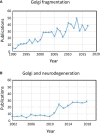Golgi Dynamics: The Morphology of the Mammalian Golgi Apparatus in Health and Disease
- PMID: 31334231
- PMCID: PMC6616279
- DOI: 10.3389/fcell.2019.00112
Golgi Dynamics: The Morphology of the Mammalian Golgi Apparatus in Health and Disease
Abstract
In vertebrate cells the Golgi consists of individual stacks fused together into a compact ribbon structure. The function of the ribbon structure of the Golgi has only begun to be appreciated (De Matteis et al., 2008; Gosavi and Gleeson, 2017; Wei and Seemann, 2017). Recent advances have identified a role for the Golgi in the regulation of a broad range of cellular processes and of particular interest is that the modulation of the Golgi ribbon is associated with regulation of a number of signaling pathways (Makhoul et al., 2018). Various cell responses, such as inflammation, and various disorders and diseases, including neurodegeneration and cancer, are associated with the loss of the Golgi ribbon and the appearance of a dispersed or semi-dispersed Golgi. Often the dispersed Golgi is referred to as a "fragmented" morphology. However, the description of a dispersed Golgi ribbon as "fragmented" is inadequate as it does not accurately define the morphological state of the Golgi. This issue is particularly relevant as there are an increasing number of reports describing Golgi fragmentation under physiological and pathological conditions. Knowledge of the precise Golgi architecture is relevant to an appreciation of the functional status of the Golgi apparatus and the underlying molecular mechanism for the contribution of the Golgi to different cellular processes. Here we propose a classification to define the various morphological states of the non-ribbon architecture of the Golgi in mammalian cells as a guide to more precisely define the relationship between the morphological and functional status of this organelle.
Keywords: Golgi morphology; Golgi ribbon; Golgi stacks; cell sensing; signaling.
Figures


References
-
- Blackburn J. B., Lupashin V. V. (2016). Creating knockouts of conserved oligomeric golgi complex subunits using CRISPR-mediated gene editing paired with a selection strategy based on glycosylation defects associated with impaired COG complex function. Methods Mol. Biol. 1496 145–161. 10.1007/978-1-4939-6463-5_12 - DOI - PMC - PubMed
LinkOut - more resources
Full Text Sources

